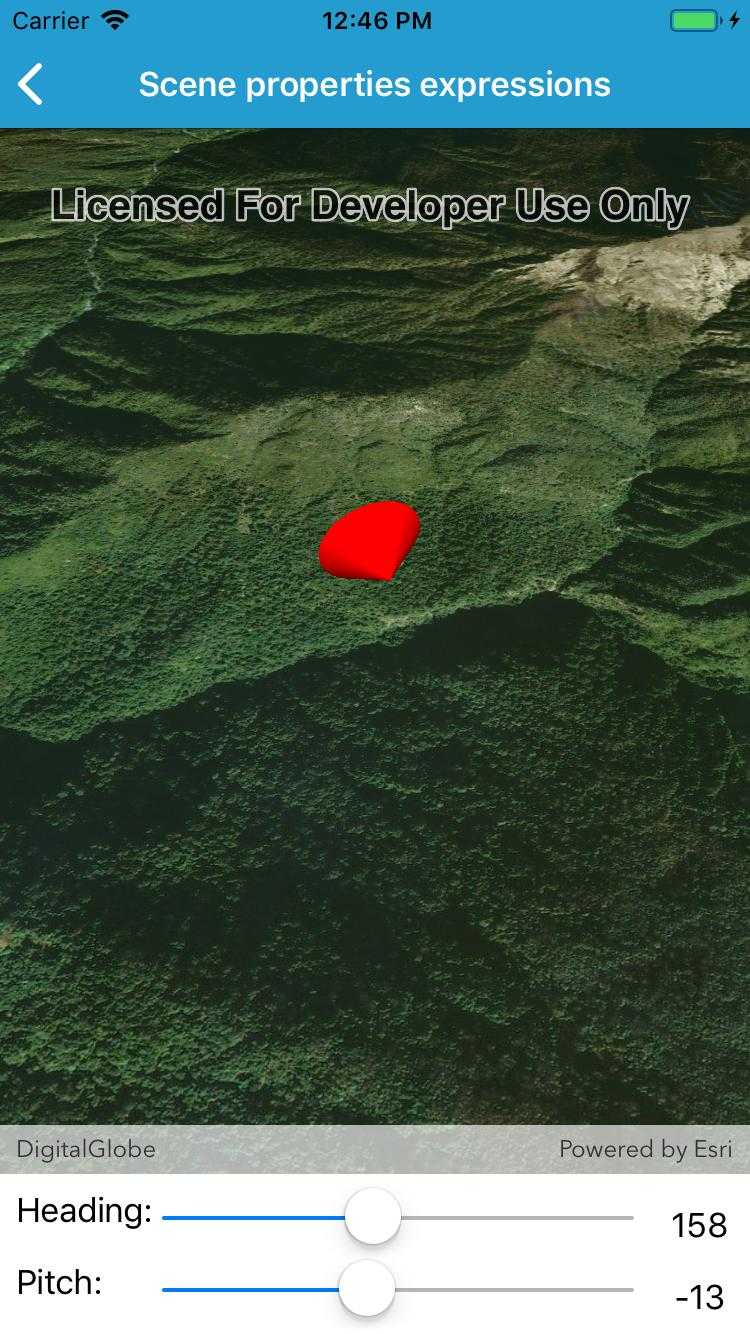Update the orientation of a graphic using expressions based on its attributes.

Use case
Instead of reading the attribute and changing the rotation on the symbol for a single graphic (a manual CPU operation), you can bind the rotation to an expression that applies to the whole overlay (an automatic GPU operation). This usually results in a noticeable performance boost (smooth rotations).
How to use the sample
Adjust the heading and pitch sliders to rotate the cone.
How it works
- Create a new graphics overlay.
- Create a simple renderer and set its scene properties.
- Set the heading expression to
[HEADING]. - Apply the renderer to the graphics overlay.
- Create a graphic and add it to the overlay.
- To update the graphic's rotation, update the HEADING or PITCH property in the graphic's attributes.
Relevant API
- Graphic.Attributes
- GraphicsOverlay
- SceneProperties
- SceneProperties.HeadingExpression
- SceneProperties.PitchExpression
- SimpleRenderer
- SimpleRenderer.SceneProperties
Tags
3D, expression, graphics, heading, pitch, rotation, scene, symbology
Sample Code
ScenePropertiesExpressions.cs
// Copyright 2019 Esri.
//
// Licensed under the Apache License, Version 2.0 (the "License"); you may not use this file except in compliance with the License.
// You may obtain a copy of the License at: http://www.apache.org/licenses/LICENSE-2.0
//
// Unless required by applicable law or agreed to in writing, software distributed under the License is distributed on an
// "AS IS" BASIS, WITHOUT WARRANTIES OR CONDITIONS OF ANY KIND, either express or implied. See the License for the specific
// language governing permissions and limitations under the License.
using System;
using System.Drawing;
using ArcGISRuntime;
using Esri.ArcGISRuntime.Geometry;
using Esri.ArcGISRuntime.Mapping;
using Esri.ArcGISRuntime.Symbology;
using Esri.ArcGISRuntime.UI;
using Esri.ArcGISRuntime.UI.Controls;
using Foundation;
using UIKit;
namespace ArcGISRuntimeXamarin.Samples.ScenePropertiesExpressions
{
[Register("ScenePropertiesExpressions")]
[ArcGISRuntime.Samples.Shared.Attributes.Sample(
name: "Scene properties expressions",
category: "GraphicsOverlay",
description: "Update the orientation of a graphic using expressions based on its attributes.",
instructions: "Adjust the heading and pitch sliders to rotate the cone.",
tags: new[] { "3D", "expression", "graphics", "heading", "pitch", "rotation", "scene", "symbology" })]
public class ScenePropertiesExpressions : UIViewController
{
// Hold references to UI controls.
private SceneView _mySceneView;
private UISlider _headingSlider;
private UISlider _pitchSlider;
private UILabel _pitchValueLabel;
private UILabel _headingValueLabel;
private Graphic _cone;
public ScenePropertiesExpressions()
{
Title = "Scene properties expressions";
}
private void Initialize()
{
// Set up the scene with an imagery basemap.
_mySceneView.Scene = new Scene(BasemapStyle.ArcGISImageryStandard);
// Set the initial viewpoint for the scene.
MapPoint point = new MapPoint(83.9, 28.4, 1000, SpatialReferences.Wgs84);
Camera initialCamera = new Camera(point, 1000, 0, 50, 0);
_mySceneView.SetViewpointCamera(initialCamera);
// Create a graphics overlay.
GraphicsOverlay overlay = new GraphicsOverlay();
overlay.SceneProperties.SurfacePlacement = SurfacePlacement.Relative;
_mySceneView.GraphicsOverlays.Add(overlay);
// Add a renderer using rotation expressions.
SimpleRenderer renderer = new SimpleRenderer();
renderer.SceneProperties.HeadingExpression = "[HEADING]";
renderer.SceneProperties.PitchExpression = "[PITCH]";
// Apply the renderer to the graphics overlay.
overlay.Renderer = renderer;
// Create a red cone graphic.
SimpleMarkerSceneSymbol coneSymbol = SimpleMarkerSceneSymbol.CreateCone(Color.Red, 100, 100);
coneSymbol.Pitch = -90;
MapPoint conePoint = new MapPoint(83.9, 28.41, 200, SpatialReferences.Wgs84);
_cone = new Graphic(conePoint, coneSymbol);
// Add the cone graphic to the overlay.
overlay.Graphics.Add(_cone);
}
private void HeightSlider_ValueChanged(object sender, EventArgs e)
{
_cone.Attributes["HEADING"] = _headingSlider.Value;
_headingValueLabel.Text = _headingSlider.Value.ToString("###");
}
private void PitchSlider_ValueChanged(object sender, EventArgs e)
{
_cone.Attributes["PITCH"] = _pitchSlider.Value;
_pitchValueLabel.Text = _pitchSlider.Value.ToString("###");
}
public override void LoadView()
{
// Create and configure views.
_mySceneView = new SceneView();
_mySceneView.TranslatesAutoresizingMaskIntoConstraints = false;
_headingSlider = new UISlider();
_headingSlider.TranslatesAutoresizingMaskIntoConstraints = false;
_headingSlider.MinValue = 0;
_headingSlider.MaxValue = 360;
_pitchSlider = new UISlider();
_pitchSlider.TranslatesAutoresizingMaskIntoConstraints = false;
_pitchSlider.MinValue = -90;
_pitchSlider.MaxValue = 90;
UILabel headingLabel = new UILabel();
headingLabel.TranslatesAutoresizingMaskIntoConstraints = false;
headingLabel.Text = "Heading: ";
UILabel pitchLabel = new UILabel();
pitchLabel.TranslatesAutoresizingMaskIntoConstraints = false;
pitchLabel.Text = "Pitch:";
_pitchValueLabel = new UILabel();
_pitchValueLabel.TranslatesAutoresizingMaskIntoConstraints = false;
_pitchValueLabel.TextAlignment = UITextAlignment.Center;
_headingValueLabel = new UILabel();
_headingValueLabel.TranslatesAutoresizingMaskIntoConstraints = false;
_headingValueLabel.TextAlignment = UITextAlignment.Center;
View = new UIView {BackgroundColor = ApplicationTheme.BackgroundColor};
// Add the views.
View.AddSubviews(_mySceneView, _headingSlider, _pitchSlider, headingLabel, _headingValueLabel, pitchLabel, _pitchValueLabel);
// Configure constraints.
_mySceneView.TopAnchor.ConstraintEqualTo(View.SafeAreaLayoutGuide.TopAnchor).Active = true;
_mySceneView.BottomAnchor.ConstraintEqualTo(headingLabel.TopAnchor).Active = true;
_mySceneView.LeadingAnchor.ConstraintEqualTo(View.LeadingAnchor).Active = true;
_mySceneView.TrailingAnchor.ConstraintEqualTo(View.TrailingAnchor).Active = true;
pitchLabel.BottomAnchor.ConstraintEqualTo(View.SafeAreaLayoutGuide.BottomAnchor, -8).Active = true;
pitchLabel.LeadingAnchor.ConstraintEqualTo(View.SafeAreaLayoutGuide.LeadingAnchor, 8).Active = true;
pitchLabel.HeightAnchor.ConstraintEqualTo(36).Active = true;
headingLabel.BottomAnchor.ConstraintEqualTo(pitchLabel.TopAnchor).Active = true;
headingLabel.LeadingAnchor.ConstraintEqualTo(pitchLabel.LeadingAnchor).Active = true;
headingLabel.TrailingAnchor.ConstraintEqualTo(pitchLabel.TrailingAnchor).Active = true;
headingLabel.HeightAnchor.ConstraintEqualTo(36).Active = true;
_headingSlider.BottomAnchor.ConstraintEqualTo(headingLabel.BottomAnchor).Active = true;
_headingSlider.TrailingAnchor.ConstraintEqualTo(_headingValueLabel.LeadingAnchor, -8).Active = true;
_headingSlider.LeadingAnchor.ConstraintEqualTo(headingLabel.TrailingAnchor).Active = true;
_pitchSlider.LeadingAnchor.ConstraintEqualTo(pitchLabel.TrailingAnchor).Active = true;
_pitchSlider.TrailingAnchor.ConstraintEqualTo(_pitchValueLabel.LeadingAnchor, -8).Active = true;
_pitchSlider.BottomAnchor.ConstraintEqualTo(pitchLabel.BottomAnchor).Active = true;
_pitchValueLabel.TrailingAnchor.ConstraintEqualTo(View.SafeAreaLayoutGuide.TrailingAnchor).Active = true;
_pitchValueLabel.WidthAnchor.ConstraintEqualTo(50).Active = true;
_pitchValueLabel.BottomAnchor.ConstraintEqualTo(pitchLabel.BottomAnchor).Active = true;
_headingValueLabel.TrailingAnchor.ConstraintEqualTo(_pitchValueLabel.TrailingAnchor).Active = true;
_headingValueLabel.LeadingAnchor.ConstraintEqualTo(_pitchValueLabel.LeadingAnchor).Active = true;
_headingValueLabel.BottomAnchor.ConstraintEqualTo(headingLabel.BottomAnchor).Active = true;
}
public override void ViewDidLoad()
{
base.ViewDidLoad();
Initialize();
}
public override void ViewWillAppear(bool animated)
{
base.ViewWillAppear(animated);
// Subscribe to events.
_headingSlider.ValueChanged += HeightSlider_ValueChanged;
_pitchSlider.ValueChanged += PitchSlider_ValueChanged;
}
public override void ViewDidDisappear(bool animated)
{
base.ViewDidDisappear(animated);
// Unsubscribe from events, per best practice.
_headingSlider.ValueChanged -= HeightSlider_ValueChanged;
_pitchSlider.ValueChanged -= PitchSlider_ValueChanged;
}
}
}